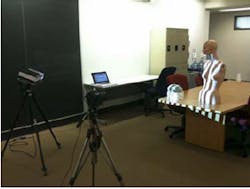New technique improves 3-D reconstruction accuracy in structured light systems
A University of Pennsylvania (Philadelphia, PA, USA) researcher has developed a means to improve the accuracy of 3-D reconstructions in structured light systems.
The use of structured light is a tried and tested approach that is commonly used to reconstruct the 3-D structure of an object or a scene.
In their simplest form, structured light systems use a projector that illuminates a scene with a pattern and a camera that captures a series of images of that pattern.
However, according to Camillo Taylor from the GRASP laboratory at the University of Pennsylvania, the resolution of digital light projectors has failed to keep up with the resolution of the cameras. The result is that standard structured light decoding schemes are limited by the resolution of the projector.
To overcome this limitation, Taylor has developed an approach that actually exploits the blur induced by the optics of the projector to improve the accuracy of the 3-D reconstruction.
Further information on the technique, which was presented at the IEEE Workshop on the Applications of Computer Vision, can be found here: http://tiny.cc/6f352
-- By Dave Wilson, Senior Editor, Vision Systems Design
